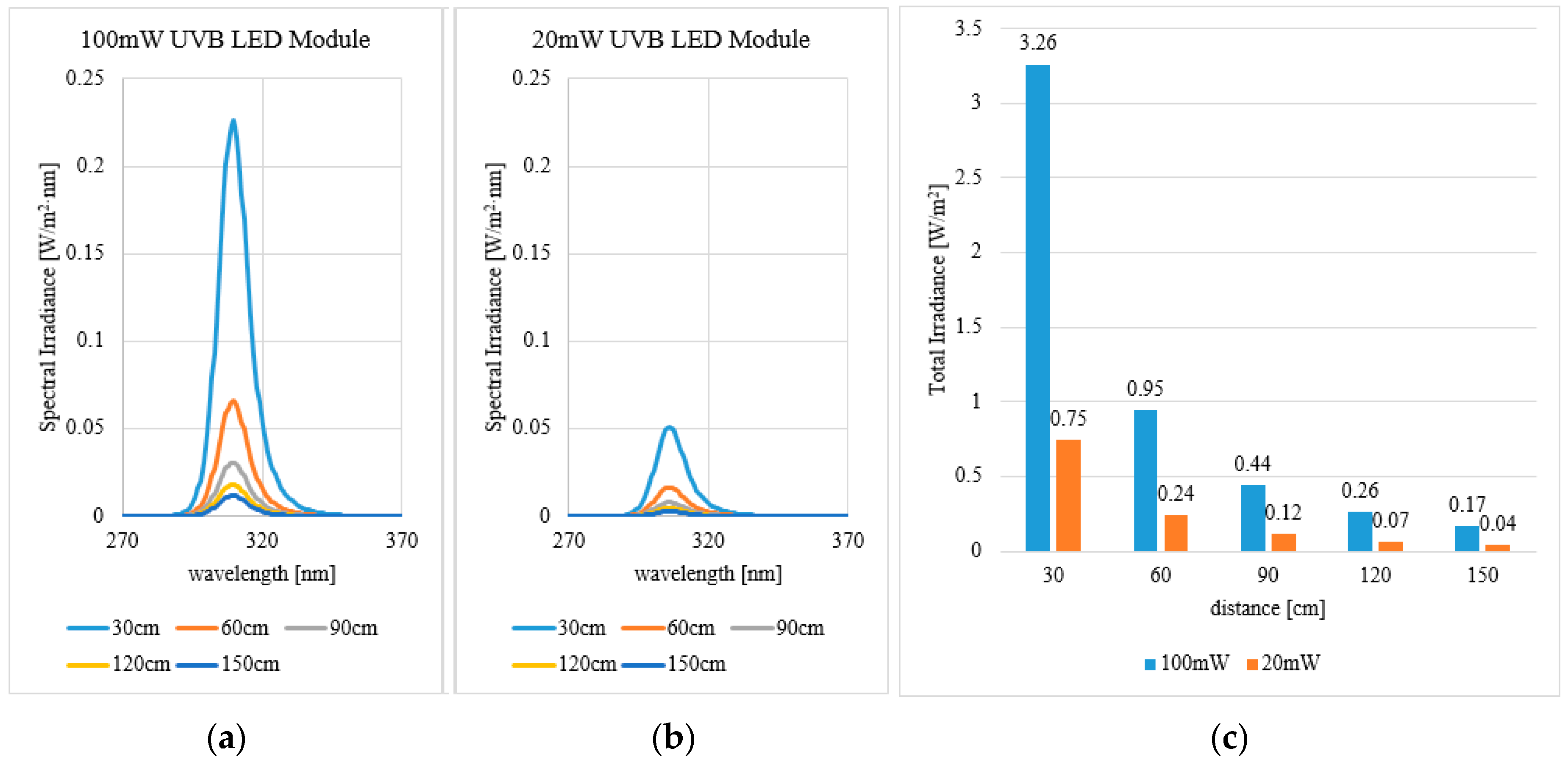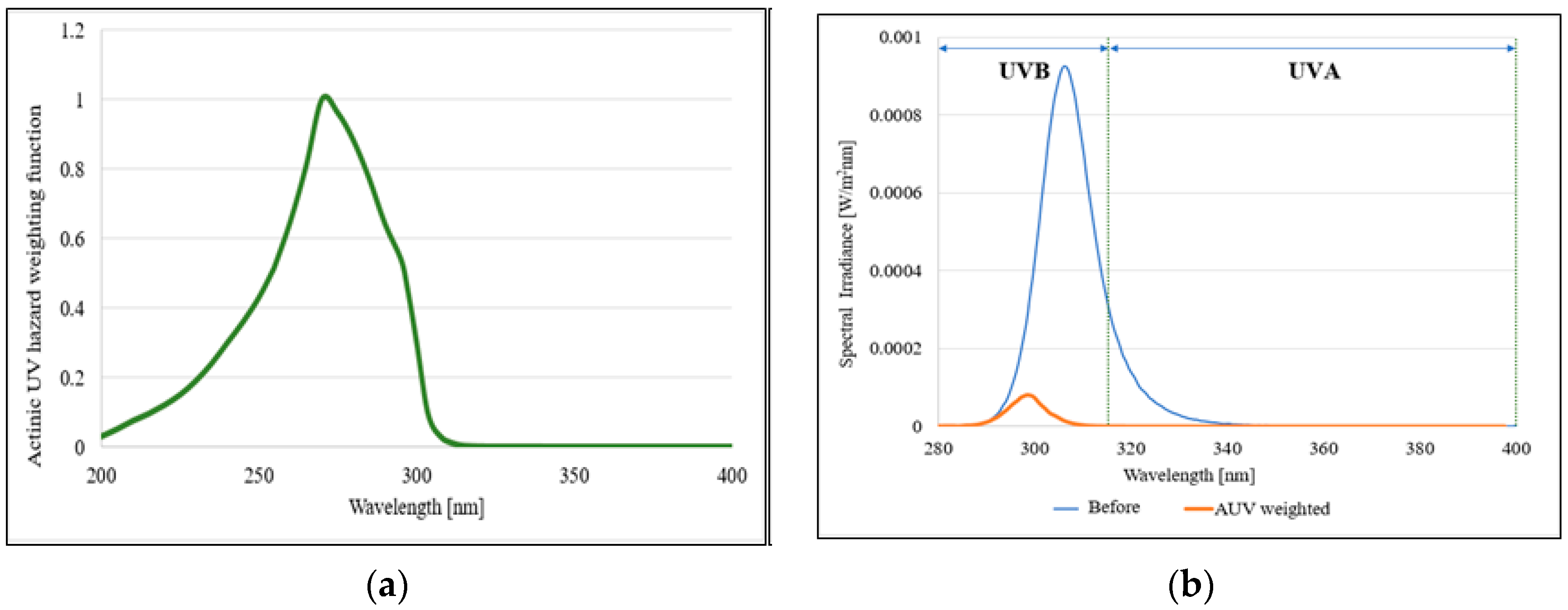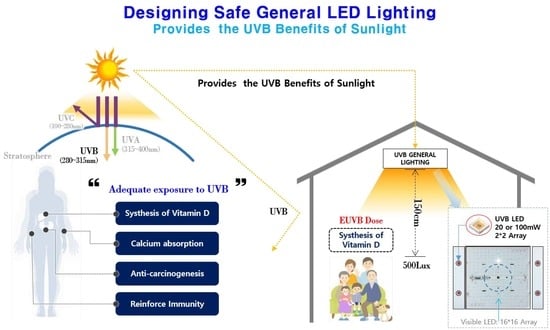Designing Safe General LED Lighting that Provides the UVB Benefits of Sunlight
Abstract
:1. Introduction
2. Methods: UVB Characteristics of Natural Light
3. Methods: UVB LED General Lighting Design
3.1. UV Safety Evaluation
3.2. Overall Lighting Design Using the UVB LED Light Source
4. Results and Discussion
5. Conclusions and Future Research
Author Contributions
Acknowledgments
Conflicts of Interest
References
- Rass, K.; Reichrath, J. UV damage and DNA repair in malignant melanoma and nonmelanoma skin cancer. In Sunlight, Vitamin D and Skin Cancer; Springer: New York, NY, USA, 2008; pp. 162–178. [Google Scholar]
- Diffey, B.L. Sources and measurement of ultraviolet radiation. Methods 2002, 28, 4–13. [Google Scholar] [CrossRef] [Green Version]
- Preston, D.S.; Stern, R.S. Nonmelanoma cancers of the skin. N. Engl. J. Med. 1992, 327, 1649–1662. [Google Scholar] [CrossRef] [PubMed]
- Armstrong, B.K.; Kricker, A. The epidemiology of UV induced skin cancer. J. Photochem. Photobiol. B Biol. 2001, 63, 8–18. [Google Scholar] [CrossRef]
- Sliney, D.H. Photoprotection of the eye—UV radiation and sunglasses. J. Photochem. Photobiol. B Biol. 2001, 64, 166–175. [Google Scholar] [CrossRef]
- Grant, W.B. The effect of solar UVB doses and vitamin D production, skin cancer action spectra, and smoking in explaining links between skin cancers and solid tumours. Eur. J. Cancer 2008, 44, 12–15. [Google Scholar] [CrossRef] [PubMed]
- Felton, S.J.; Cooke, M.S.; Kift, R.; Berry, J.L.; Webb, A.R.; Lam, P.M.W.; de Gruijl, F.R.; Vail, A.; Rhodes, L.E. Concurrent beneficial (vitamin D production) and hazardous (cutaneous DNA damage) impact of repeated low-level summer sunlight exposures. Br. J. Dermatol. 2016, 175, 1320–1328. [Google Scholar] [CrossRef] [PubMed] [Green Version]
- Moan, J.; Porojnicu, A.C.; Dahlback, A.; Setlow, R.B. Addressing the health benefits and risks, involving vitamin D or skin cancer, of increased sun exposure. Proc. Natl. Acad. Sci. USA 2008, 105, 668–673. [Google Scholar] [CrossRef] [PubMed] [Green Version]
- Brustad, M.; Edvardsen, K.; Wilsgaard, T.; Engelsen, O.; Aksnes, L.; Lund, E. Seasonality of UV-radiation and vitamin D status at 69 degrees north. Photochem. Photobiol. Sci. 2007, 6, 903–908. [Google Scholar] [CrossRef] [PubMed]
- Holick, M.F. Sunlight and vitamin D for bone health and prevention of autoimmune diseases, cancers, and cardiovascular disease. Am. J. Clin. Nutr. 2004, 80, 1678S–1688S. [Google Scholar] [CrossRef] [PubMed]
- Milaneschi, Y.; Shardell, M.; Corsi, A.M.; Vazzana, R.; Bandinelli, S.; Guralnik, J.M.; Ferrucci, L. Serum 25-hydroxyvitamin D and depressive symptoms in older women and men. J. Clin. Endocrinol. Metab. 2010, 95, 3225–3233. [Google Scholar] [CrossRef] [PubMed]
- Cannell, J.J.; Hollis, B.W. Use of vitamin D in clinical practice. Altern. Med. Rev. 2008, 13, 6. [Google Scholar] [PubMed]
- Rosen, C.J. Vitamin D insufficiency. N. Engl. J. Med. 2011, 364, 248–254. [Google Scholar] [CrossRef] [PubMed]
- McKenzie, R.L.; Ben, L.J.; Lars, O.B. UV radiation: Balancing risks and benefits. Photochem. Photobiol. 2009, 85, 88–98. [Google Scholar] [CrossRef] [PubMed]
- Farrar, M.D.; Webb, A.R.; Kift, R.; Durkin, M.T.; Allan, D.; Herbert, A.; Berry, J.L. Efficacy of a dose range of simulated sunlight exposures in raising vitamin D status in South Asian adults: Implications for targeted guidance on sun exposure. Am. J. Clin. Nutr. 2013, 97, 1210–1216. [Google Scholar] [CrossRef] [PubMed]
- Holick, M.F. Vitamin D deficiency. N. Engl. J. Med. 2007, 357, 266–281. [Google Scholar] [CrossRef] [PubMed]
- Webb, A.R.; Kift, R.; Berry, J.L.; Rhodes, L.E. The vitamin D debate: Translating controlled experiments into reality for human sun exposure times. Photochem. Photobiol. 2011, 87, 741–745. [Google Scholar] [CrossRef] [PubMed]
- Long, C.M.; Suh, H.H.; Catalano, P.J.; Koutrakis, P. Using time-and size-resolved particulate data to quantify indoor penetration and deposition behavior. Environ. Sci. Technol. 2001, 35, 2089–2099. [Google Scholar] [CrossRef] [PubMed]
- Sexton, A.L. Responses to Air Quality Alerts: Do Americans Spend Less Time Outdoors. Ph.D. Thesis, University of Minnesota, Minneapolis, MN, USA, 2012. [Google Scholar]
- Noonan, D.S. Smoggy with a Chance of Altruism: The Effects of Ozone Alerts on Outdoor Recreation and Driving in A tlanta. Policy Stud. J. 2014, 42, 122–145. [Google Scholar] [CrossRef]
- Kim, H.S.; Oh, S.T.; Lim, J.H. Development of local area alert system against particulate matters and ultraviolet rays based on open IoT platform with P2P. Peer-to-Peer Netw. Appl. 2018, 11, 1240–1251. [Google Scholar] [CrossRef]
- Barnkob, L.L.; Argyraki, A.; Petersen, P.M.; Jakobsen, J. Investigation of the effect of UV-LED exposure conditions on the production of vitamin D in pig skin. Food Chem. 2016, 212, 386–391. [Google Scholar] [CrossRef] [PubMed] [Green Version]
- Park, R.J.; Cho, Y.H.; Park, S.H.; Lee, Y.M. The study of characteristic of induced erythema and safety by UVB lamp. J. Korean Phys. Ther. 2006, 18, 79–87. [Google Scholar]
- Cheng, Y.K.; Cheng, K.W.E. General study for using LED to replace traditional lighting devices. In Proceedings of the ICPESA’06, 2nd International Conference on Power Electronics Systems and Applications, Hong Kong, China, 12–14 November 2006. [Google Scholar]
- Lim, S. Phototherapy and the benefits of LEDs. J. Soc. Inf. Disp. 2011, 19, 882–887. [Google Scholar] [CrossRef]
- Bang, G.W.; Kim, Y.H. LED for plant growth regulators for the study of light on the device. J. Digit. Converg. 2012, 10, 267–272. [Google Scholar]
- International Electrotechnical Commission. IEC 62471: 2006 Photobiological safety of lamps and lamp systems. In International Standard; International Electrotechnical Commission: Geneva, Switzerland, 2006. [Google Scholar]
- ICNIRP. Guidelines on limits of exposure to ultraviolet radiation of wavelengths between 180 nm and 400 nm (incoherent optical radiation). Health Phys. 2004, 87, 171–186. [Google Scholar] [CrossRef]
- Fantozzi, F.; Leccese, F.; Rocca, M.; Salvadori, G. Risk assessment arising from exposure to artificial optical radiation. In Proceedings of the 2017 IEEE International Conference on Environment and Electrical Engineering and 2017 IEEE Industrial and Commercial Power Systems Europe (EEEIC/I&CPS Europe), Milan, Italy, 6–9 June 2017. [Google Scholar]
- World Health Organization and International Commission on Non-Ionizing Radiation Protection. Global Solar UV Index: A Practical Guide (No. WHO/SDE/OEH/02.2); World Health Organization: Geneva, Switzerland, 2002. [Google Scholar]
- Korea Meteorological Administration. The total UV Index calculation method and program. In Sumary of Korea Global Atmosphere Watch; Korea Meteorological Administration: Seoul, Korea, 2014. [Google Scholar]
- McKenzie, R.; Blumthaler, M.; Diaz, S.; Fioletov, V.; Herman, J.; Seckmeyer, G.; Smedley, A.; Webb, A. Rationalizing Nomenclature for UV Doses and Effects on Humans; CIE 209:2014; WMO: Geneva, Switzerland, 2014. [Google Scholar]
- Kim, K.M. Design of Lighting System to Support Vitamin D Synthesis Using Natural Light Measurement Data. Master’s Thesis, Kongju University, Gongju, Korea, 2018. [Google Scholar]
- Kwak, M.K.; Jae, H.K. The radiative characteristics of EUV-B over the Korean Peninsula and exposure time for synthesizing adequate vitamin D. Atmosphere 2011, 21, 123–130. [Google Scholar]
- Robinson, I.A. Watt and Joule balances. Metrologia 2014, 51, S1. [Google Scholar] [CrossRef]
- Cho, H.K.; Kwon, H.J.; Choi, C.Y. Increase of the surface erythemal ultraviolet-B radiation by the ozone layer depletion. J. Kor Meteorol. Soc. 1998, 34, 272–281. [Google Scholar]
- Ko, J.K.; Cho, M.R.; Lee, M.J.; Kim, J.H. Analysis on IEC 62471 for the introduction of photobiological safety of LED lamp. In Proceedings of the Safety Management and Science Conference, Yongin, Korea, 17 November 2012. [Google Scholar]







| Model (Company) | Image | Spectral Range [nm] | Number of Pixels | Resolution [nm] |
|---|---|---|---|---|
| CAS140CT 152 (Instrument Systems) |  | 200–800 | 1024 × 768 | 2.7 |
| Hazard Items | Unit | Exempt | Risk Group 1 | Risk Group 2 |
|---|---|---|---|---|
| Actinic ultraviolet hazard (AUV) | W/m2 | 0.001 | 0.003 | 0.03 |
| Near-UV hazard (NUV) | W/m2 | 10 | 33 | 100 |
| Model Name | Size (L*W*H) (mm) | Peak Wavelength | Optical Power (mW) | Maximum Current [mA] |
|---|---|---|---|---|
| LEUVA66G00KV00 | 6.0 × 6.0 × 1.35 | 295~315 nm | 20 | 350 |
| LEUVA66H00KU00 | 6.0 × 6.0 × 1.35 | 300~310 nm | 100 | 350 |
| Applied Current (mA) | 20 mW UVB LED | 100 mW UVB LED | ||||||||
|---|---|---|---|---|---|---|---|---|---|---|
| UV | UVB | UVA | EUVB | EUVA | UV | UVB | UVA | EUVB | EUVA | |
| 50 | 0.00064 | 0.00053 | 0.00011 | 0.00015 | 0.00000 | 0.00282 | 0.00218 | 0.00064 | 0.00040 | 0.00001 |
| 100 | 0.00131 | 0.00111 | 0.00020 | 0.00032 | 0.00000 | 0.00564 | 0.00439 | 0.00125 | 0.00080 | 0.00001 |
| 150 | 0.00196 | 0.00167 | 0.00029 | 0.00048 | 0.00000 | 0.00829 | 0.00646 | 0.00183 | 0.00118 | 0.00002 |
| 200 | 0.00262 | 0.00223 | 0.00039 | 0.00064 | 0.00000 | 0.01077 | 0.00837 | 0.00240 | 0.00152 | 0.00003 |
| 250 | 0.00324 | 0.00277 | 0.00047 | 0.00079 | 0.00001 | 0.01308 | 0.01012 | 0.00296 | 0.00182 | 0.00003 |
| 300 | 0.00386 | 0.00330 | 0.00056 | 0.00094 | 0.00001 | 0.01527 | 0.01173 | 0.00354 | 0.00210 | 0.00004 |
| 350 | 0.00449 | 0.00383 | 0.00066 | 0.00108 | 0.00001 | 0.01733 | 0.01322 | 0.00411 | 0.00234 | 0.00005 |
| Item | Reference Value | Result Value after Measurement | Hazard Rating |
|---|---|---|---|
| Actinic ultraviolet hazard (AUV) | 0.001 W/m2 | 0.001 W/m2 | Exempt |
| Near-UV hazard (NUV) | 10 W/m2 | 0.002 W/m2 | Exempt |
© 2019 by the authors. Licensee MDPI, Basel, Switzerland. This article is an open access article distributed under the terms and conditions of the Creative Commons Attribution (CC BY) license (http://creativecommons.org/licenses/by/4.0/).
Share and Cite
Oh, S.-T.; Park, D.-H.; Lim, J.-H. Designing Safe General LED Lighting that Provides the UVB Benefits of Sunlight. Appl. Sci. 2019, 9, 826. https://doi.org/10.3390/app9050826
Oh S-T, Park D-H, Lim J-H. Designing Safe General LED Lighting that Provides the UVB Benefits of Sunlight. Applied Sciences. 2019; 9(5):826. https://doi.org/10.3390/app9050826
Chicago/Turabian StyleOh, Seung-Taek, Dae-Hwan Park, and Jae-Hyun Lim. 2019. "Designing Safe General LED Lighting that Provides the UVB Benefits of Sunlight" Applied Sciences 9, no. 5: 826. https://doi.org/10.3390/app9050826





